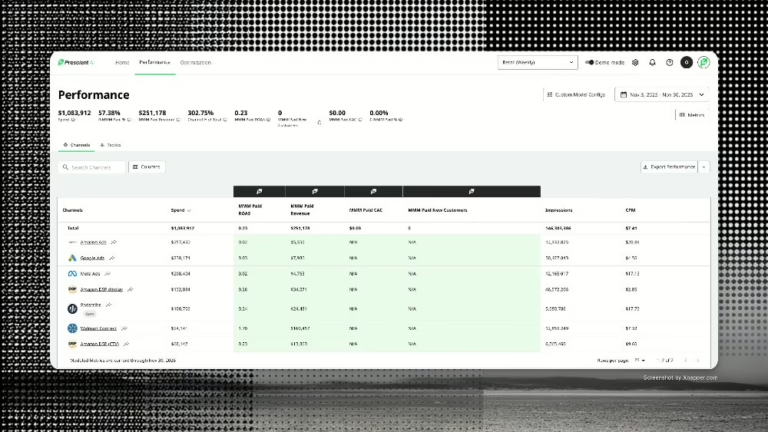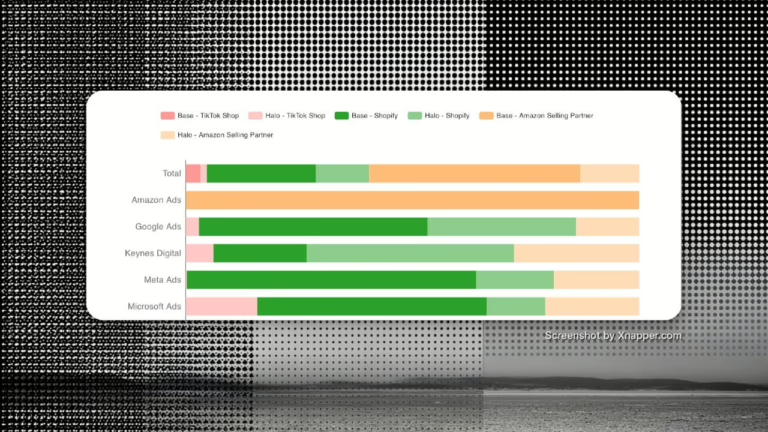Imagine trying to understand the climate of San Francisco using only its average annual temperature of 57°F. You’d miss the famous fog, the microclimates, the seasonal shifts, and the daily fluctuations that actually define the city’s weather experience. Marketing efficiency ratio (MER) presents a similar challenge—a single number attempting to capture the complexity of your entire marketing ecosystem. While this simplicity makes MER appealing as a high-level metric, it also raises an important question: does this consolidated view provide meaningful guidance for marketing decisions, or does it obscure the nuanced reality marketers need to navigate?
What is marketing efficiency ratio (MER)?
Marketing efficiency ratio represents the relationship between your total revenue and your total marketing spend across all channels. Unlike return on ad spend (ROAS) which typically measures performance at the campaign or channel level, MER takes a holistic approach by dividing total revenue by total marketing spend. This calculation yields a simple ratio: a MER of 5 means you’re generating $5 in revenue for every $1 spent on marketing.
The formula’s simplicity explains its growing popularity among marketing teams. Rather than juggling separate ROAS calculations for each channel, MER offers a consolidated view of overall marketing performance. This perspective aligns with the reality that consumers rarely interact with just one marketing channel before converting, making MER particularly relevant in our omnichannel world.
Most direct-to-consumer brands typically aim for a MER between 1.5 and 4.0, with specific targets varying based on factors like profit margins, growth goals, and business maturity. While newer brands might accept a lower MER during growth phases, established companies with stable customer bases generally expect higher efficiency from their marketing dollars.
The appeal of MER as a marketing metric
MER’s greatest strength lies in its acknowledgment that marketing channels don’t operate in isolation. When a customer sees your YouTube ad, then later converts through paid search, traditional siloed ROAS metrics might overvalue the search campaign while undervaluing the YouTube initiative that initiated the journey. MER sidesteps this attribution challenge by measuring collective performance instead.
This holistic perspective makes MER particularly valuable for executive communications. While CMOs and marketing managers need granular campaign insights, CEOs and CFOs often prefer a single number that captures marketing’s overall contribution to revenue. MER serves this purpose effectively, providing stakeholders with an accessible efficiency metric that doesn’t require deep marketing expertise to interpret.
MER also helps break down the arbitrary walls between marketing channels. By focusing on collective performance rather than individual channel metrics, it encourages teams to think about marketing as an interconnected ecosystem rather than competing silos. This perspective can foster more collaborative approaches to campaign planning and budget allocation.
The limitations of MER as a standalone metric
Despite these advantages, MER contains significant blind spots that limit its usefulness for tactical decision-making. Most critically, MER treats all marketing dollars as equal contributors to revenue generation, regardless of their actual impact. This aggregation can mask underperforming campaigns and channels, allowing inefficiencies to hide within otherwise acceptable overall numbers.
MER also fails to capture the nuanced relationship between top-of-funnel and bottom-of-funnel activities. Brand awareness campaigns might show poor efficiency when measured in isolation, yet they create the foundation for later conversions driven by performance marketing. Without understanding these halo effects—how campaigns influence organic traffic, direct visits, and branded search—MER calculations remain fundamentally incomplete.
The timing dimension presents another challenge. Different marketing initiatives influence consumer behavior on different timelines, with some campaigns generating immediate results while others create effects that persist for weeks or months. Standard MER calculations typically ignore these carryover effects, potentially undervaluing campaigns with longer-lasting impact in favor of those with immediate but short-lived returns.
The context needed to make MER truly valuable
To transform MER from a simplistic ratio into a genuinely useful metric, marketers need supplemental insights that provide essential context. Understanding campaign-level performance remains critical even when tracking overall efficiency. This granularity helps identify which specific initiatives drive efficiency improvements or declines, enabling targeted optimizations rather than blanket budget adjustments.
Properly contextualizing MER also requires accounting for halo effects—the indirect revenue impacts of your marketing activities. When a social media campaign drives not just direct conversions but also lifts in organic traffic and branded search, that additional revenue belongs in your efficiency calculations. Without capturing these effects, MER systematically undervalues upper-funnel marketing activities.
Business planning context significantly impacts how marketers should interpret and target MER. Rather than establishing a fixed MER target to pursue relentlessly, sophisticated marketers understand that efficiency ratios often represent an output of broader business objectives in your P&L calculations. During customer acquisition pushes, MER will naturally decline as you invest in finding new customers with higher acquisition costs. Conversely, during promotional periods, MER might temporarily spike to unsustainable levels that shouldn’t become your new benchmark. Recognizing these planned fluctuations prevents knee-jerk reactions to efficiency changes that actually align with your strategic business initiatives.
External factors also significantly influence MER without reflecting actual marketing performance. Seasonal fluctuations, competitor activities, pricing changes, and even macroeconomic conditions can dramatically shift your efficiency ratio independent of campaign quality. Interpreting MER without considering these variables risks misattributing external effects to marketing performance.
How Prescient AI enhances marketing efficiency understanding
While our platform doesn’t directly report MER as a platform metric, its capabilities provide the essential context needed to make overall efficiency measurements meaningful. The platform’s halo effect modeling reveals the true revenue impact of each campaign beyond direct conversions, capturing how initiatives influence organic traffic, direct visits, and branded search performance. This comprehensive view prevents the systematic undervaluation of top-of-funnel activities that plagues standard efficiency calculations.
Prescient’s approach to modeling different decay patterns across campaigns also addresses a fundamental limitation of standard marketing efficiency metrics. Rather than assuming all marketing impacts occur immediately or decay at uniform rates, we capture the unique carryover patterns of each campaign. This temporal understanding reveals which initiatives deliver sustained revenue impact versus those with only short-term effects—critical context for accurate efficiency assessment.
Our platform’s campaign-level insights complement overall efficiency metrics by revealing which specific initiatives drive collective performance. Instead of treating marketing as a monolithic entity, We show how each campaign contributes to the larger picture, enabling targeted optimizations that improve overall efficiency without sacrificing strategic initiatives. This granularity transforms high-level metrics from diagnostic tools into actionable intelligence.
Best practices for using MER in your marketing strategy
The most effective approach to MER integrates this high-level metric within a more comprehensive measurement framework. Use MER for what it does best—providing an accessible overview of collective marketing performance—while relying on more granular metrics like campaign-specific ROAS, halo effects, and contribution margin for tactical decisions. For example, a fashion retailer might maintain a dashboard that displays overall MER alongside campaign-level ROAS, allowing them to quickly identify whether efficiency changes stem from specific channels or represent a broader trend.
When communicating MER to stakeholders, provide essential context to prevent misinterpretation. A direct-to-consumer brand launching into a new customer segment might prepare executives by explaining that their typical MER of 4.0 will temporarily drop to 2.5 during the expansion phase, highlighting the strategic investment in future growth. Similarly, when seasonal promotions drive MER from 3.0 to 5.0, clarify that this represents a temporary efficiency spike rather than a new sustainable benchmark. This contextual framing transforms MER from a potentially misleading simplification into a valuable starting point for deeper discussion.
Setting appropriate MER targets requires aligning efficiency goals with specific business initiatives rather than rigidly applying industry benchmarks. A subscription business might deliberately accept a lower 1.8 MER during Q1 when acquiring customers with high lifetime value, then shift to a more conservative 3.0 target in Q3 when focusing on profitability. Similarly, an established brand might temporarily permit MER to drop from 4.0 to 2.5 when expanding into new channels like TikTok or OTT that require initial learning investments before reaching optimal efficiency. These flexible, initiative-based targets acknowledge that marketing efficiency serves broader business objectives rather than existing as an end goal itself.
Wrapping it up…
Marketing efficiency ratio offers valuable high-level insights into collective marketing performance, but its simplicity becomes a limitation when used without proper context. Like trying to understand San Francisco’s climate from a single temperature figure, using MER in isolation obscures the complex interplay between channels, the varying timelines of marketing impact, and the indirect effects that significantly influence true efficiency.
The most sophisticated marketers neither dismiss MER entirely nor rely on it exclusively. Instead, they recognize it as one component within a more comprehensive measurement approach that captures the nuanced reality of modern marketing. With proper contextualization—understanding campaign-level performance, accounting for halo effects, and recognizing temporal patterns—MER transforms from a potentially misleading oversimplification into a valuable strategic indicator.
Ready to gain the deeper insights needed to make MER truly meaningful? Book a demo with Prescient AI today to discover how our platform can help you understand the complete picture of your marketing impact, from direct conversions to halo effects and beyond.


